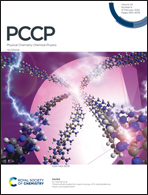Decomposing and analyzing contact resonance frequency in contact mode voltage modulated scanning probe microscopies†
Abstract
Contact mode voltage modulated scanning probe microscopy (SPM) techniques, such as switching spectroscopy piezoresponse force microscopy (SS-PFM), are powerful tools for detecting local electromechanical behaviors. However, interpreting their signals, especially the contact resonance frequency (f0), is difficult due to the complexity of the tip-sample contact and the signal tracking system. In a previous study, an interesting phenomenon on the variation of f0 was observed, showing distinctions between ferroelectric and non-ferroelectric materials. Therefore, it is believed that f0 conveys important information about the tip-sample contact which is real-timely affected by charge accumulation or polarization switching. In this study, principal component analysis (PCA) and correlation analysis are applied to decompose the signal of f0. The first and second principal components successfully restore most information of the original data, and they describe different features which are related to the surface morphology and electromechanical behavior, respectively. In addition, a customized method based on the PCA and correlation analysis of f0 can well distinguish the responses from different materials of which the amplitude and phase signals show “ferroelectric like” phenomena during the SS-PFM measurements.



 Please wait while we load your content...
Please wait while we load your content...